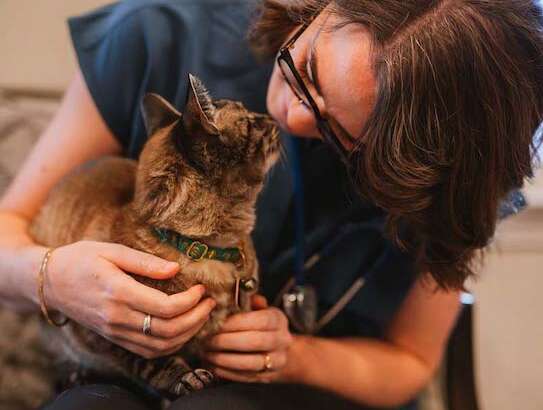T
here is nothing harder as a pet parent than having to say goodbye to your beloved companion when it’s their time. The challenge, in most cases, is knowing when to let them go and making this decision on their behalf with confidence and peace of mind. However, when we’re overwhelmed with so  many emotions as we’re processing it all, the clear decision can become rather cloudy. As a pet parent who has gone through this with both my 14 year old pup, Pete, and my 19 year old cat, Otis, I fully appreciate the weight and heartache involved in making these challenging end-of-life decisions. And as a Pet Care Professional with 9 to 5 Pets, we often walk hand-in-hand and grieve alongside our clients as they are navigating these difficult decisions with their beloved pets who we’ve bonded with through our day-to-day service and care. My hope in sharing this blog post is to shed some light on a difficult topic that helps pet parents understand their options and what’s best for their pets and makes the decision between euthanasia and hospice more clear.
many emotions as we’re processing it all, the clear decision can become rather cloudy. As a pet parent who has gone through this with both my 14 year old pup, Pete, and my 19 year old cat, Otis, I fully appreciate the weight and heartache involved in making these challenging end-of-life decisions. And as a Pet Care Professional with 9 to 5 Pets, we often walk hand-in-hand and grieve alongside our clients as they are navigating these difficult decisions with their beloved pets who we’ve bonded with through our day-to-day service and care. My hope in sharing this blog post is to shed some light on a difficult topic that helps pet parents understand their options and what’s best for their pets and makes the decision between euthanasia and hospice more clear.
 Understanding the differences between euthanasia and hospice care is crucial for ensuring that pet parents can make compassionate, well-informed, and personalized decisions that prioritize the well-being and comfort of their beloved pets during challenging times.
Understanding the differences between euthanasia and hospice care is crucial for ensuring that pet parents can make compassionate, well-informed, and personalized decisions that prioritize the well-being and comfort of their beloved pets during challenging times.
Understanding Euthanasia
Euthanasia is a procedure performed by a veterinarian to peacefully end the life of an animal in pain or with a significantly compromised quality of life. The primary purpose of euthanasia is to alleviate suffering and provide a compassionate and dignified end to a pet’s life when their condition is beyond the point of manageable or curable treatment. Euthanasia is often considered when the following factors come into play:
- Intractable Pain: If a pet is experiencing unmanageable pain that cannot be relieved through medical interventions, euthanasia is considered to prevent further suffering.
- Terminal Illness: In cases where a pet is diagnosed with a terminal illness, and their quality of life is rapidly deteriorating, euthanasia may be chosen to spare them from the pain and distress of the disease’s progression.
- Severe Injury: When a pet has suffered a severe and debilitating injury with little to no hope of recovery, euthanasia may be chosen to prevent prolonged agony.
- Loss of Quality of Life: If a pet’s quality of life has significantly declined, and they are no longer able to perform normal daily activities, such as eating, drinking, or moving, euthanasia is considered to end their suffering.
- End-of-Life Dignity: Euthanasia is often viewed as a way to ensure that a pet’s final moments are peaceful and dignified, sparing them from further pain and distress.
 Euthanasia is a difficult decision for pet owners, but it is an act of love and compassion, as it prioritizes the welfare and comfort of the pet over prolonging their suffering. Veterinary professionals perform euthanasia in a humane and gentle manner to minimize any pain or discomfort experienced by the pet during the process.
Euthanasia is a difficult decision for pet owners, but it is an act of love and compassion, as it prioritizes the welfare and comfort of the pet over prolonging their suffering. Veterinary professionals perform euthanasia in a humane and gentle manner to minimize any pain or discomfort experienced by the pet during the process.
Understanding Hospice Care
Pet hospice care is a specialized form of end-of-life care for animals, provided by veterinarians, trained professionals, or even pet owners, with the primary goal of ensuring the comfort, well-being, and dignity of a terminally ill or elderly pet during their remaining days, weeks, or months of life. Pet hospice care focuses on enhancing a pet’s quality of life by managing pain and discomfort while offering emotional support to both the pet and their owner.
 Pet hospice care includes the following:
Pet hospice care includes the following:
- Maximizing Comfort: Pet hospice care aims to minimize pain and discomfort through pain management, medication, and other palliative treatments. It provides a peaceful environment that promotes physical comfort.
- Emotional Support: Hospice care recognizes that the emotional well-being of both the pet and the pet owner is crucial during this difficult period. Caregivers provide emotional support, counseling, and guidance to help pet owners cope with their pet’s declining health.
- Maintaining Dignity: Pet hospice care ensures that the pet’s dignity is maintained throughout the end-of-life journey. This includes keeping the pet clean, comfortable, and as mobile as possible while respecting their individual preferences.
- Quality of Life: Hospice care emphasizes improving and maintaining the pet’s quality of life for as long as possible, allowing them to enjoy their remaining time with their family.
- Family Involvement: It encourages the active involvement of the pet owner and their family in the care process, fostering a sense of closeness and connection during this challenging period.
- Customized Care: Pet hospice care is tailored to the specific needs of each individual pet, taking into account their medical condition, preferences, and lifestyle.
- Education and Guidance: Caregivers provide pet owners with information about the pet’s condition, the progression of the illness, and what to expect, empowering them to make informed decisions.
- Transition to Euthanasia: In some cases, pet hospice care may also help pet owners prepare for the eventual transition to euthanasia when the pet’s suffering becomes unmanageable or their quality of life severely declines.
 Pet hospice care allows pets to live out their remaining days with dignity, comfort, and love, while providing pet owners with the opportunity to say their goodbyes in a supportive and compassionate environment. It can be an emotionally rewarding and comforting option for those facing the difficult journey of caring for a terminally ill or elderly pet.
Pet hospice care allows pets to live out their remaining days with dignity, comfort, and love, while providing pet owners with the opportunity to say their goodbyes in a supportive and compassionate environment. It can be an emotionally rewarding and comforting option for those facing the difficult journey of caring for a terminally ill or elderly pet.
Key Difference between Euthanasia and Hospice Care
Euthanasia is a more immediate, one-time choice designed to end suffering, while pet hospice care is an ongoing approach aimed at enhancing a pet’s quality of life during their remaining time. The choice between the two depends on the individual circumstances of the pet and the pet owner’s values and preferences.
Factors to Consider
 Deciding between euthanasia and pet hospice is a deeply personal and challenging decision. Several factors should be carefully considered to make the best choice for your beloved pet:
Deciding between euthanasia and pet hospice is a deeply personal and challenging decision. Several factors should be carefully considered to make the best choice for your beloved pet:
- Quality of Life: Assess your pet’s current quality of life. Consider their ability to eat, drink, move, interact, and enjoy activities. If their quality of life has severely declined, it may be time to consider euthanasia.
- Medical Condition: Understand the nature and severity of your pet’s medical condition. Terminal illnesses or severe injuries may require different considerations than conditions with a more favorable prognosis.
- Pain and Suffering: Evaluate the level of pain and suffering your pet is experiencing. If they are in unmanageable pain or discomfort, euthanasia may be a more compassionate option.
- Personal Values: Reflect on your personal values and beliefs regarding end-of-life care for your pet. Consider what aligns with your moral and ethical principles.
- Pet’s Wishes: If you have a clear understanding of your pet’s preferences and behaviors, consider what they might indicate. A sudden loss of interest in life or a drastic change in behavior could be signs that they are ready for a peaceful end.
- Prognosis: Consult with a veterinarian to understand the prognosis of your pet’s condition. They can help you weigh the potential outcomes and the likelihood of improvement or decline.
- Financial Considerations: Understand the financial implications of both euthanasia and hospice care. Hospice care may require ongoing expenses for medication, treatment, and care, while euthanasia is typically a one-time cost.
- Family and Emotional Support: Consider the emotional well-being of your family and how each option may impact them. Also, think about the support you can provide each other during this challenging time.
- Comfort Measures: Evaluate the availability of palliative care and pain management options. If you choose hospice care, ensure you can provide your pet with the necessary comfort measures.
- Ongoing Monitoring: If you choose hospice care, be prepared for ongoing monitoring and frequent vet visits. Understand the level of commitment required for this choice.
- Timing: Consider whether you have reached a point where the pet’s suffering is becoming unmanageable, or if there is still a reasonable opportunity to improve their quality of life through hospice care.
- End-of-Life Plan: If you choose hospice care, have a clear end-of-life plan in place, including criteria for transitioning to euthanasia if necessary.
- Consult with Professionals: Seek guidance from a veterinarian or a specialized pet hospice provider. They can offer valuable insights and help you understand the best course of action for your pet’s specific situation.
 Remember that the decision is ultimately about what is in the best interest of your pet and is driven by compassion and love. It can be a heart-wrenching choice, but your pet’s well-being and comfort should be the central focus when making the decision between euthanasia and pet hospice.
Remember that the decision is ultimately about what is in the best interest of your pet and is driven by compassion and love. It can be a heart-wrenching choice, but your pet’s well-being and comfort should be the central focus when making the decision between euthanasia and pet hospice.
Local Providers Who Will Come To Your Home
The following are a list of in-home euthanasia and pet hospice care providers in our area:
Dr. Katie, The Hospice Vet (904) 521-3440 Dr. Katie Stender
Your Home Vet (904) 414-4242 Care@YourHomeVetJax.com Dr. Jessica Maines
Lap of Love – Jacksonville (904) 508-0323
Coping with Grief
 Coping with the grief that follows the loss of a beloved pet, whether due to euthanasia or after providing pet hospice care, is a challenging and emotional process. Here are some resources and strategies to help you navigate this difficult time:
Coping with the grief that follows the loss of a beloved pet, whether due to euthanasia or after providing pet hospice care, is a challenging and emotional process. Here are some resources and strategies to help you navigate this difficult time:
- Pet Loss Support Groups: Check if there are local pet loss support groups in your area where you can share your feelings and experiences with others who have gone through similar situations.
- Online Pet Loss Communities: Many online forums and social media groups are dedicated to helping pet owners cope with grief. Websites like “Rainbow Bridge” and “PetLoss.com” offer supportive communities and resources.
- Grief Counseling: Consider seeking professional grief counseling or therapy to help you process your feelings and work through the grieving process. Many therapists specialize in pet loss.
- Books and Literature: Reading books and articles on pet loss and grief can provide insight and comfort.
- Memorializing Your Pet: Creating a memorial for your pet, such as a photo album, a scrapbook, or a memorial service, can be a healing way to remember and honor your pet.
- Art Therapy: Engage in creative outlets like painting, writing, or crafting to express your grief and emotions. Creating a tribute to your pet can be therapeutic.
- Mindfulness and Meditation: Mindfulness and meditation techniques can help reduce stress and provide a sense of calm during this challenging time.
- Pet Loss Hotlines: Some organizations offer pet loss hotlines staffed by trained counselors who can provide immediate support and guidance.
- Online Resources: Websites like the Association for Pet Loss and Bereavement (APLB) provide articles, coping tips, and directories of pet loss counselors.
- Reach Out to Friends and Family: Share your feelings with friends and family members who understand the bond you had with your pet. Sometimes, talking about your grief can be immensely comforting.
- Self-Care: Take care of your physical and emotional well-being. Get enough sleep, eat well, and engage in activities that bring you joy and relaxation.
- Volunteering: Some people find solace in volunteering at animal shelters or pet-related charities in memory of their pet.
Grief is a highly individual experience, and it’s important to allow yourself to grieve in your own way and at your own pace. Remember that it’s normal to experience a wide range of emotions, and healing takes time. Seek support and resources that resonate with you and offer comfort during this difficult journey.
Grief Resources
Support Groups and Online Resources:
- Pet Loss And Grief: Virtual Group Therapy Hosted by Dr. Sierra Trainor (904) 906-3848
- Good Grief: A Guide Through Pet Loss Hosted by David and Patricia Watkins (904) 616-7766 info@goodgriefpet.com
- Lap of Love Pet Loss Support
- Association for Pet Loss and Bereavement
- Rainbow Bridge
- PetLoss.com
Books For Adults:
- Goodbye, Friend: Healing Wisdom for Anyone Who Has Ever Lost a Pet by Gary Kowalski
- Illumination: Life Lessons from our Animal Companions by Lisa Shaw (Amazon e-book)
- There Are No Sad Dogs in Heaven: Finding Comfort After the Loss of a Pet by Sonya Fitzpatrick
- Coping with Sorrow on the Loss of Your Pet: Third Edition by Moira Anderson Allen M.Ed.
- Coping With the Loss of a Pet by Christina M. Lemieux
Books For Children:
- The Rainbow Bridge: A Visit to Pet Paradise by Adrian Raeside
- The Invisible Leash: An Invisible String Story About the Loss of a Pet by Patrice Karst
- I’ll Always Love You by Hans Wilhelm
- Dog Heaven by Cynthia Rylant
- When a Pet Dies by Fred Rogers
- For Every Dog an Angel by Christine Davis
- The Kids Book About Pet Loss: Grieving and Healing After Losing Your Pet (The Kids Book About . . .) by Vicky Taylor
- Memories of You: Pet Memory Book (Helping Kids Heal Series) by Erainna Winnett and Lucia Martinez
- When Your Pet Dies…: A Healing Handbook for Kids (Elf-Help Books for Kids) by Victoria Ryan and R. W. Alley
- Megan’s Journey: A Story to Help Children Through the Loss of Their Much Loved Pets by Janet Peel
Key Takeaways
 When making the difficult decision between euthanasia and hospice care for a pet, it’s essential to consider the following key takeaways:
When making the difficult decision between euthanasia and hospice care for a pet, it’s essential to consider the following key takeaways:
- Quality of Life: Assess your pet’s current quality of life, considering factors such as pain, mobility, and ability to enjoy daily activities. Euthanasia may be the right choice if their quality of life has significantly deteriorated.
- Medical Condition: Understand the nature and prognosis of your pet’s medical condition. In cases of terminal illness or severe injury, hospice care or euthanasia may be appropriate depending on the stage of the condition.
- Pain and Suffering: If your pet is in unmanageable pain or discomfort, and there are limited treatment options, euthanasia may provide a compassionate and peaceful way to end their suffering.
- Personal Values: Reflect on your personal values and beliefs regarding pet care and end-of-life decisions. The choice should align with your moral and ethical principles.
- Pet’s Wishes: Consider your pet’s behavior and preferences. Sudden changes in behavior, appetite, or interest in life may provide insights into their comfort and readiness.
- Prognosis: Consult with a veterinarian to understand the prognosis of your pet’s condition. They can help you weigh potential outcomes and the likelihood of improvement or decline.
- Emotional Support: Recognize that the emotional well-being of your family and yourself is essential. Reach out to support groups, therapists, and resources for guidance during the process.
- Financial Considerations: Understand the financial implications of both options, including ongoing costs for hospice care and the one-time expense of euthanasia.
- End-of-Life Plan: If you choose hospice care, have a clear end-of-life plan in place, including criteria for transitioning to euthanasia if necessary.
- Professional Guidance: Consult with a veterinarian or pet hospice provider to receive guidance and insights into the best course of action for your pet’s specific situation.
As pet parents and Pet Care Professionals, we understand and empathize with how difficult it is to say goodbye to our beloved pets. Ultimately, whether you decide euthanasia or hospice care, your decision should prioritize your pet’s well-being and comfort and be guided by compassion and love. Each pet’s situation is unique, and there’s no one-size-fits-all answer. Trust your instincts and make the choice that best serves your pet’s individual needs and circumstances.

